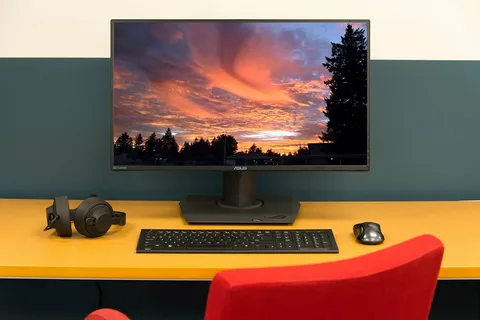Choosing a monitor is a compromise between picture quality, working speed and financial possibilities. Conventionally, displays can be divided into office, multimedia, gaming, and professional. Regardless of its type, everyone can enjoy the simplest activities from writing texts to betting at 22 Bet. Let’s find out what characteristics you should pay attention to so as not to regret the purchase.
Aspect Ratio and Diagonal
Table of Contents
Shape and size is the first thing the user thinks about when choosing a monitor. Over time, devices with an aspect ratio of 5:4 and 4:3 are a thing of the past. Also, the 16:10, which was loved by professionals, went to rest. Today, the most popular models are 16:9 and 21:9.
The size of 16:9 monitors can be as follows:
- Less than 23.5 inches – budget devices, most of which are made on a TN matrix. They are taken to offices to perform the simplest work tasks.
- 24 inches – one of the most popular diagonals. Valued for versatility, a wide range of models and an affordable price. Most often these monitors are based on IPS or VA with FHD resolution.
- 27-28 inches is the most common size, especially loved by gamers and professionals. For 27 inches, the optimal resolution is 2K. That said, 28-inch models tend to have 4K resolution and require scaling.
- 32 inches – most of these displays come in 2K or 4K resolution. The first option is relevant for games, the second – for movies and editing programs.
- Over 32 inches – single copies, in appearance resembling TVs. In the most extreme cases, their diagonal reaches 42, 48 and even 55 inches.
The 21:9 format is in good demand in recent years. Its unexpected popularity can be explained by several reasons. Firstly, such monitors became really indispensable for some professional tasks. Secondly, it increases the effect of immersion in games and movies. Thirdly, ultrawide monitors managed to firmly occupy its niche due to the competitive price. However, older games and movies don’t support this ratio and come with black bars on the sides. Ultra-wide monitors can be found on the market in three sizes:
- 29-30 inches are the outgoing devices with a resolution of 2,560 × 1,080 pixels.
- 34 inches is the most popular diagonal, which, combined with its curved shape and 3440 × 1440 pixel resolution, is a great option for gaming and watching videos.
- 38 inches – looks spectacular on the table, but has too high a price. They are rare.
Separately there are monitors with an aspect ratio of 32:9. Most often they are bought to replace two side by side displays 16:9. Most of these models have a diagonal of 49 inches and a resolution of 5120 × 1440 pixels.
Curved Screen
In the TV sphere, curved matrices have failed, but in monitors, this solution is popular, providing maximum immersion in games and movies. At least that’s what marketers say. The smaller the radius of curvature, the greater the curvature. Typical values are 1000R, 1500R and 1800R. And curved VA monitors cost significantly less than their IPS counterparts.
However, these screens are not suitable for everyone. Because of tangible perspective distortion they won’t allow you to work with drawings and 3D-models. Media content on them looks just great.
Resolution
Screen resolution is the number of pixels horizontally, multiplied by the number of pixels vertically. The higher the resolution, the sharper and more detailed the picture. Unfortunately, the load on the graphics card also increases.
- 1920 × 1080 pixels (FHD, Full HD) is a popular resolution with a huge amount of video content. Most of the 24/27 inch monitors come with FHD. It’s in demand among eSportsmen and gamers with limited budgets. The first are interested in maximum FPS, the latter hope to get along without significant investments in the graphics adapter.
- 2560 × 1440 pixels has a good picture and relatively low graphics card requirements. Is a great option for a variety of scenarios of use: from graphics to AAA-games.
- 3840 × 2160 pixels gives the most detailed images and has huge hardware requirements, but this resolution is the future. How far into the future depends largely on video card manufacturers. 4K is best suited for monitors with a diagonal of 32 inches and above. Otherwise, the image will be very shallow, causing the need for scaling.
- 6016 × 3384 pixels is the resolution of Apple’s Pro Display XDR monitors, designed for designers and criers on an enviable budget.
- 7680 × 4320 pixels (8K UHD) – found in several superprofessional models. Price starts at 700,000 rubles.
Ultra-wide monitors mainly come with two types of resolution: 2560×1080 and 3440×1440 pixels. The last option is typical for monitors with a diagonal of 34 inches and its capabilities are closer to 2K resolution, which has a positive impact on gaming. A good mid-range video card will unlock the potential of such a monitor.
Type of Screen
The most important element of any monitor – the matrix. Despite the marketing confusion, the real choice today is between two options – OLED and LED. The latter in turn is divided into TN, VA and IPS.
TN + film (Twisted Nematic) is a dying type of matrix, which definitely should not be considered when buying a home monitor. The disadvantages are low viewing angles and mediocre color rendering. The only advantages are low price and good response time. Thanks to the latter, TN monitors are still valued by some cyber athletes.
VA (Vertical Alignment) is one of the key players on the market. Its main trump cards are a high level of static contrast and good blacks. A controversial point is the relatively small viewing angles. It’s also believed that VA matrixes are less suitable for fast-paced games because of the increased response time and guesting. These problems were solved in high-speed VA, which are equipped with some top models of Samsung Odyssey.
IPS (In-Plane Switching) is the most versatile option. IPS has excellent viewing angles, color reproduction and response speed. The payoff is a low contrast ratio, which these matrices rarely exceed 1000:1. Black is more like a dark gray, and when you look from the side, you can notice the glow effect – the appearance of a stray brown-orange hue on the dark background.
Gaming monitors from some manufacturers are equipped with fast IPS-matrices – the so-called Fast IPS or Rapid IPS. They have a reduced response time and can compete in speed with TN, while providing excellent color rendering. The name is rather a marketing name, so you should look for the cherished words either on the box or on the manufacturer’s website.
Vision Protection Technologies
After a long sitting in front of the monitor, people may notice fatigue and red eyes, a feeling of sand and even a headache. Much of this effect can be attributed to the use of PWM (Pulse Width Modulation) in the device. To reduce flicker and protect users’ eyes, an increasing number of manufacturers are equipping their monitors with Flicker-Free/Flicker Safe vision protection systems. OLED-based models are an exception – they use PWM modulation at a low brightness level due to technological peculiarities.
The Low Blue Light function filters out excess blue light with a wavelength of 420-450 nm. It’s believed that such radiation negatively affects not only the eyes, but also the night’s sleep.







